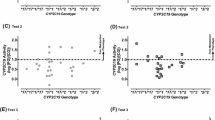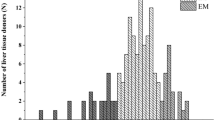Abstract
Purpose
Cytochrome P450 2C19 (CYP2C19) is clinically important for the metabolism of many therapeutic drugs. CYP2C19 has two main point mutation sites leading to low metabolic capacity. Several CYP enzymes are also important for the metabolism of chemical carcinogens, and several studies have reported associations between CYP polymorphism and cancer susceptibility. Speculating on a potential association between CYP2C19 polymorphism and cancer susceptibility, we conducted this study in two phases. Cell lines of various gastroenterological cancers were screened in the first phase. A clinical investigation was then conducted to confirm the association with the candidate cancer in the second phase.
Methods
Genetic polymorphism of CYP2C19 was investigated in a total of 114 cell lines of five gastroenterological cancers. Based on this screening investigation suggesting an association with biliary tract cancer, we conducted a related study by recruiting 65 patients with biliary tract cancer and 566 patients with benign diseases as controls.
Results
Among the 114 cell lines investigated, biliary tract cancer was suggested to be most strongly associated with poor metabolizers of CYP2C19. Among 65 patients with biliary tract cancer, 18 (28%) were poor metabolizers of CYP2C19, whereas 87 (15%) of 566 control patients were poor metabolizers. The age- and gender-adjusted odds ratios for intermediate and poor metabolizers regarding the risk of biliary tract cancer were 1.5 (95% CI: 0.8–3.0, P = 0.17) and 2.7 (1.3–5.9, P = 0.006) compared to extensive metabolizers.
Conclusions
A genetic polymorphism of CYP2C19 is associated with susceptibility to biliary tract cancer.

Similar content being viewed by others
References
Chiba K, Kobayashi K, Manabe K, Tani M, Kamataki T, Ishizaki T. Oxidative metabolism of omeprazole in human liver microsomes: cosegregation with S-mephenytoin 4′-hydroxylation. J Pharmacol Exp Ther. 1993;266:52–9.
Ishizaki T, Sohn DR, Kobayashi K, Chiba K, Lee KH, Shin SG, et al. Interethnic differences in omeprazole metabolism in the two S-mephenytoin hydroxylation phenotypes studied in Caucasians and Orientals. Ther Drug Monit. 1994;16:214–5.
Ieiri I, Kubota T, Urae A, Kimura M, Wada Y, Mamiya K, et al. Pharmacokinetics of omeprazole (a substrate of CYP2C19) and comparison with two mutant alleles, C gamma P2C19m1 in exon 5 and C gamma P2C19m2 in exon 4, in Japanese subjects. Clin Pharmacol Ther. 1996;59:647–53.
Bertilsson L, Henthorn TK, Sanz E, Tybring G, Sawe J, Villen T. Importance of genetic factors in the regulation of diazepam metabolism: relationship to S-mephenytoin, but not debrisoquin, hydroxylation phenotype. Clin Pharmacol Ther. 1989;45:348–55.
Skjelbo E, Brosen K, Hallas J, Gram LF. The mephenytoin oxidation polymorphism is partially responsible for the N-demethylation of imipramine. Clin Pharmacol Ther. 1991;49:18–23.
Ward SA, Walle T, Walle UK, Wilkinson GR, Branch RA. Propranolol’s metabolism is determined by both mephenytoin and debrisoquin hydroxylase activities. Clin Pharmacol Ther. 1989;45:72–9.
Kobayashi K, Yamamoto T, Chiba K, Tani M, Ishizaki T, Kuroiwa Y. The effects of selective serotonin reuptake inhibitors and their metabolites on S-mephenytoin 4′-hydroxylase activity in human liver microsomes. Br J Clin Pharmacol. 1995;40:481–5.
Collet JP, Hulot JS, Pena A, Villard E, Esteve JB, Silvain J, et al. Cytochrome P450 2C19 polymorphism in young patients treated with clopidogrel after myocardial infarction: a cohort study. Lancet 2009;373:309–17.
Mega JL, Close SL, Wiviott SD, Shen L, Hockett RD, Brandt JT, et al. Cytochrome p-450 polymorphisms and response to clopidogrel. N Engl J Med. 2009;360:354–62.
Kubota T, Chiba K, Ishizaki T. Genotyping of S-mephenytoin 4′-hydroxylation in an extended Japanese population. Clin Pharmacol Ther. 1996;60:661–6.
De Morais SM, Wilkinson GR, Blaisdell J, Meyer UA, Nakamura K, Goldstein JA. Identification of a new genetic defect responsible for the polymorphism of (S)-mephenytoin metabolism in Japanese. Mol Pharmacol. 1994;46:594–8.
de Morais SM, Wilkinson GR, Blaisdell J, Nakamura K, Meyer UA, Goldstein JA. The major genetic defect responsible for the polymorphism of S-mephenytoin metabolism in humans. J Biol Chem. 1994;269:15419–22.
Furuta T, Ohashi K, Kosuge K, Zhao XJ, Takashima M, Kimura M, et al. CYP2C19 genotype status and effect of omeprazole on intragastric pH in humans. Clin Pharmacol Ther. 1999;65:552–61.
Klotz U. Clinical impact of CYP2C19 polymorphism on the action of proton pump inhibitors: a review of a special problem. Int J Clin Pharmacol Ther. 2006;44:297–302.
Furuta T, Ohashi K, Kamata T, Takashima M, Kosuge K, Kawasaki T, et al. Effect of genetic differences in omeprazole metabolism on cure rates for Helicobacter pylori infection and peptic ulcer. Ann Intern Med. 1998;129:1027–30.
Jeurissen SM, Bogaards JJ, Boersma MG, ter Horst JP, Awad HM, Fiamegos YC, et al. Human cytochrome p450 enzymes of importance for the bioactivation of methyleugenol to the proximate carcinogen 1′-hydroxymethyleugenol. Chem Res Toxicol. 2006;19:111–6.
Degawa M. Chemical carcinogenesis and cytochrome P450: carcinogenic aromatic amine-induced P450 and hepatocarcinogenic susceptibility to the aromatic amine in the rodent. Yakugaku Zasshi. 1995;115:1–14.
Shi WX, Chen SQ. Frequencies of poor metabolizers of cytochrome P450 2C19 in esophagus cancer, stomach cancer, lung cancer and bladder cancer in Chinese population. World J Gastroenterol. 2004;10:1961–3.
Roddam PL, Rollinson S, Kane E, Roman E, Moorman A, Cartwright R, et al. Poor metabolizers at the cytochrome P450 2D6 and 2C19 loci are at increased risk of developing adult acute leukaemia. Pharmacogenetics. 2000;10:605–15.
Sugimoto M, Furuta T, Shirai N, Nakamura A, Kajimura M, Sugimura H, et al. Poor metabolizer genotype status of CYP2C19 is a risk factor for developing gastric cancer in Japanese patients with Helicobacter pylori infection. Aliment Pharmacol Ther. 2005;22:1033–40.
Nagahashi M, Ajioka Y, Lang I, Szentirmay Z, Kasler M, Nakadaira H, et al. Genetic changes of p53, K-ras, and microsatellite instability in gallbladder carcinoma in high-incidence areas of Japan and Hungary. World J Gastroenterol. 2008;14:70–5.
Yamamoto M, Haga M, Takagi S, Endoh K, Ito S, Yoshida K, et al. HLA antigens in cancer of the gallbladder. Tohoku J Exp Med. 1990;161:69–71.
Sheth S, Bedford A, Chopra S. Primary gallbladder cancer: recognition of risk factors and the role of prophylactic cholecystectomy. Am J Gastroenterol. 2000;95:1402–10.
WHO (2006) Mortality database. http://www.who.int/healthinfo/morttables/en/index.html
Serra I, Yamamoto M, Calvo A, Cavada G, Baez S, Endoh K, et al. Association of chili pepper consumption, low socioeconomic status and longstanding gallstones with gallbladder cancer in a Chilean population. Int J Cancer. 2002;102:407–11.
Xie HG. Genetic variations of S-mephenytoin 4′-hydroxylase (CYP2C19) in the Chinese population. Life Sci. 2000;66:PL175–81.
Xie HG, Kim RB, Stein CM, Wilkinson GR, Wood AJ. Genetic polymorphism of (S)-mephenytoin 4′-hydroxylation in populations of African descent. Br J Clin Pharmacol. 1999;48:402–8.
Yamamoto S. Biliary tract cancer mortality rates by prefectures in Japan. Jpn J Clin Oncol. 2000;30:576.
Adachi Y. Changes in the concentrations of chlornitrofen (CNP) and CNP-amino in river and faucet water in Niigata, Japan. Nippon Eiseigaku Zasshi. 1994;48:1090–8.
Kawajiri K, Nakachi K, Imai K, Yoshii A, Shinoda N, Watanabe J. Identification of genetically high risk individuals to lung cancer by DNA polymorphisms of the cytochrome P450IA1 gene. FEBS Lett. 1990;263:131–3.
Drakoulis N, Cascorbi I, Brockmoller J, Gross CR, Roots I. Polymorphisms in the human CYP1A1 gene as susceptibility factors for lung cancer: exon-7 mutation (4889 A to G), and a T to C mutation in the 3′-flanking region. Clin Investig. 1994;72:240–8.
Shi X, Zhou S, Wang Z, Zhou Z. CYP1A1 and GSTM1 polymorphisms and lung cancer risk in Chinese populations: a meta-analysis. Lung Cancer. 2008;59:155–63.
Uematsu F, Ikawa S, Kikuchi H, Sagami I, Kanamaru R, Abe T, et al. Restriction fragment length polymorphism of the human CYP2E1 (cytochrome P450IIE1) gene and susceptibility to lung cancer: possible relevance to low smoking exposure. Pharmacogenetics. 1994;4:58–63.
Aktas D, Guney I, Alikasifoglu M, Yuce K, Tuncbilek E, Ayhan A. CYP1A1 gene polymorphism and risk of epithelial ovarian neoplasm. Gynecol Oncol. 2002;86:124–8.
Nimura Y, Yokoyama S, Fujimori M, Aoki T, Adachi W, Nasu T, et al. Genotyping of the CYP1A1 and GSTM1 genes in esophageal carcinoma patients with special reference to smoking. Cancer. 1997;80:852–7.
Lin DX, Tang YM, Peng Q, Lu SX, Ambrosone CB, Kadlubar FF. Susceptibility to esophageal cancer and genetic polymorphisms in glutathione S-transferases T1, P1, and M1 and cytochrome P450 2E1. Cancer Epidemiol Biomarkers Prev. 1998;7:1013–8.
Murata M, Watanabe M, Yamanaka M, Kubota Y, Ito H, Nagao M, et al. Genetic polymorphisms in cytochrome P450 (CYP) 1A1, CYP1A2, CYP2E1, glutathione S-transferase (GST) M1 and GSTT1 and susceptibility to prostate cancer in the Japanese population. Cancer Lett. 2001;165:171–7.
Hayashi SI, Watanabe J, Nakachi K, Kawajiri K. PCR detection of an A/G polymorphism within exon 7 of the CYP1A1 gene. Nucleic Acids Res. 1991;19:4797.
Marchand LL, Wilkinson GR, Wilkens LR. Genetic and dietary predictors of CYP2E1 activity: a phenotyping study in Hawaii Japanese using chlorzoxazone. Cancer Epidemiol Biomarkers Prev. 1999;8:495–500.
Conflict of interest statement
There was no conflict of interest in this study.
Author information
Authors and Affiliations
Corresponding author
Rights and permissions
About this article
Cite this article
Isomura, Y., Yamaji, Y., Ohta, M. et al. A genetic polymorphism of CYP2C19 is associated with susceptibility to biliary tract cancer. J Gastroenterol 45, 1045–1052 (2010). https://doi.org/10.1007/s00535-010-0246-0
Received:
Accepted:
Published:
Issue Date:
DOI: https://doi.org/10.1007/s00535-010-0246-0




